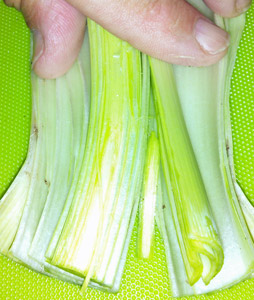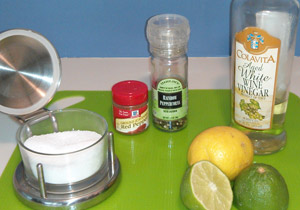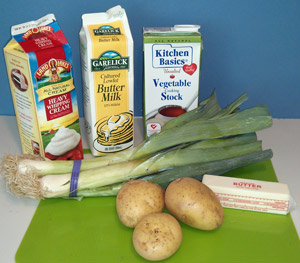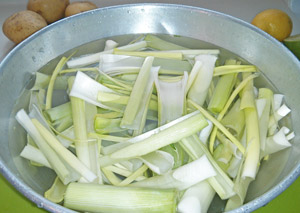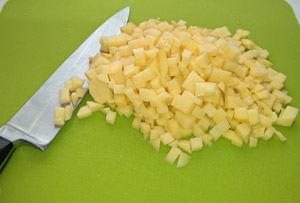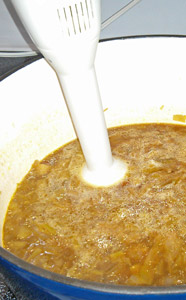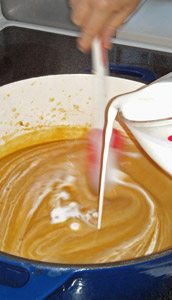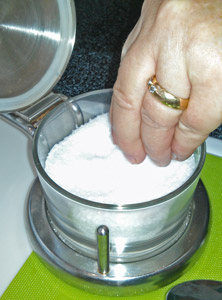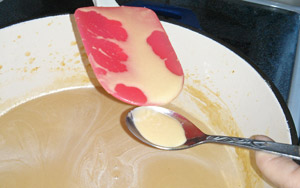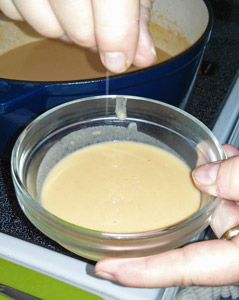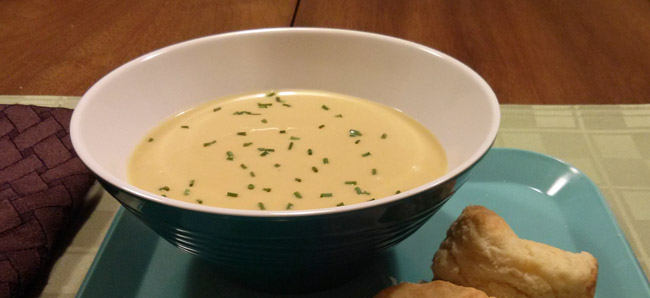 In many recipes you’ll see the words, “season to taste”. Most cooks just throw in a little salt and pepper and hope for the best, but there are some useful techniques to produce better tasting food. With the recipe below, we’ll replicate an exercise we learned taking recreational classes at our local culinary school. It’s easy, fun, and maybe you’ll learn something as well! We’re using leek and potato soup because it’s easy to work with, but you could also try the exercise on anything you happen to be cooking, preferably a soup, stew, or one-dish meal.
In many recipes you’ll see the words, “season to taste”. Most cooks just throw in a little salt and pepper and hope for the best, but there are some useful techniques to produce better tasting food. With the recipe below, we’ll replicate an exercise we learned taking recreational classes at our local culinary school. It’s easy, fun, and maybe you’ll learn something as well! We’re using leek and potato soup because it’s easy to work with, but you could also try the exercise on anything you happen to be cooking, preferably a soup, stew, or one-dish meal.
Leek and Potato Soup
- 1 pound leeks (4 to 5 medium)
- Kosher salt
- 3 tablespoons butter
- 3 small to medium potatoes (preferably Yukon Gold), peeled and finely diced
- 1 quart vegetable broth (can substitute chicken broth)
- 1 cup heavy cream
- 1 cup buttermilk (can substitute milk, yogurt, sour cream, or crema)
- 1/2 teaspoon white pepper (can substitute ground black pepper)
- 1 tablespoon snipped fresh chives (optional, or substitute minced parsley)
Directions:
-
Carefully clean the leeks, as they generally have a lot of grit. First cut off and discard the root end and the dark green portions. Slice the body of the leek in half lengthwise. An easy way to clean the leek is to fan apart the layers and drop them into a large bowl of water. Agitate until clean, then fish out the pieces of leek. Pat dry and chop into pieces. You don’t have to be precise in your chopping because the soup will be pureed later.
- Melt the butter in a large saucepan or Dutch oven over medium heat. Add the leeks with a good pinch of salt. Cook the leeks at medium heat for a few minutes, then reduce heat to medium-low and cook for about 25 minutes, stirring occasionally.
- Add potatoes and broth, and bring to a boil over medium-high heat. Reduce the heat to low, cover, and simmer until the potatoes are very soft, about 45 minutes.
- Turn off the heat and puree the mixture with an immersion blender until smooth (see “The Well-Equipped Galley”). Stir in the cream, buttermilk, and white pepper. “Season to taste”*, then sprinkle with chives and serve immediately, or chill and serve cold.
*”Season to taste”: okay, now the fun begins! Arm yourself with two small bowls, a stirring spoon, and a tasting spoon. Collect your arsenal of seasoning tools: salt, pepper, something acidic for brightness (lemon juice, lime juice, or some type of vinegar — depending on what you are making), and something to add a little zing (cayenne pepper, sriracha, bottled hot sauce, crushed red pepper flakes).
First, use your stirring spoon to put a little soup on your tasting spoon and try it. You may think that it tastes pretty good at this point, but trust us, it’s going to get better. Use your stirring spoon to put a little soup into one of your small bowls, and set the bowl aside. We’ll come back to that later.
Add a couple of large pinches of salt. Stir the salt in well and give it another taste. As you add salt, it shouldn’t taste “salty”, but you should start to pick up more and more flavor of the ingredients — in this case the leeks and potatoes. Keep adding salt until the soup is very flavorful. How do you know if one more addition of salt is going to be too much? This is where your second small bowl comes into play. Put a small amount of soup in the bowl and add more salt. Taste. If the salt improves the flavor, add more to the full pot. If not, it’s time to stop. What if you’ve added too much salt? Don’t worry — adding a little of your acid will back off the saltiness of the dish!
Once you’ve brought up the flavors of the ingredients using salt, it’s time to balance the flavor using your other tools. We almost always find that a little acid improves a dish, and for our tastes, a little heat is good as well. Use the techniques of tasting and testing in a small bowl to make the soup taste good to you. Everyone’s taste is different!
Once you have tasted the completed soup, go back and take a taste of the soup we initially set aside in a small bowl. It will probably taste incredibly bland to you. See — you’ve just learned how to make everything taste better in one easy lesson!
Because we are going to serve the leek and potato soup chilled on this hot summer day, we will taste and adjust the seasoning again just before serving. You may find that foods served cold will require additional seasoning.
But wait, you might say — isn’t all that salt bad for you? The major source of sodium in the North American diet is processed food, and especially fast food. We like to use salt to make our home-cooked food taste better. The trade-off we make is to avoid processed foods so that we feel we can use salt liberally in the galley. If we end up using 1 – 1 1/2 teaspoons of salt in the recipe above, I estimate that the total sodium content of the soup will be 450 – 600 mg of sodium per serving. For comparison purposes, most canned or boxed soups have around 750- 800 mg per serving, as does a small chili at Wendy’s. A Quarter-Pounder with Cheese at McDonald’s has 1100 mg of sodium. So, season to taste without guilt, and enjoy your soup!
Fair winds and following seas,
Heather, The Cruising Cook
| Seasoning Leek and Potato Soup | |

